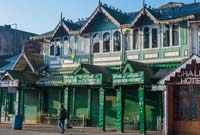 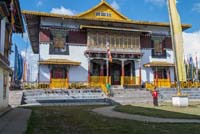 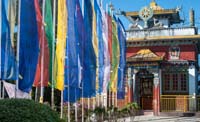  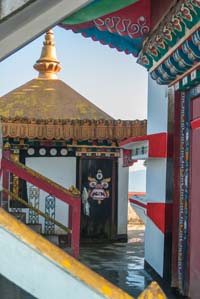  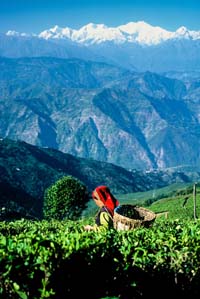  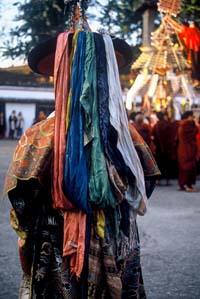   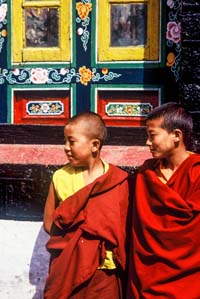
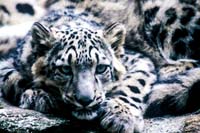
|
Mountains and Monasteries 8 days out of Delhi Day 1: Fly from Delhi to Bagdogra There is a morning flight from Delhi to Bagdogra, the airport on the plains below Darjeeling. Arrange for a car and driver to pick you up and drive you to Darjeeling – about 4 hours if you stop for tea at Kurseong along the way. Darjeeling, according to the Shambhala legend, is one of the “Hidden Valleys” set aside as sanctuaries for devout Buddhists during times of troubles. It is easy to see how such a romantic mystique grew around this enchanting hillside locale. So different from the Indian plains that you leave behind as you drive up the steep winding road, through the flickering teak forests, and lush tea plantations. You rapidly gain altitude until the 28,200 ft Mt Khanchenjunga, the “King of Mountains”, dominates the northern horizon, its massive white snow summit brilliant against the indigo skies. Darjeeling is situated at about 7000 ft (2150 meters). N.B. If you do not already have your permit for Sikkim, you should apply for that at Sikkim Tourism desk at the Bagdogra Airport before you leave. It’s free, but you will need photos and a copy of your passport. Day 2: Darjeeling Early to rise this morning to watch the sun come up over Himalayas from the viewpoint at Tiger Hill. Khanchenjunga, the third highest mountain in the world, is surely one of the most impressive, and sunrise here is a spectacle not to be missed. Its name, “Khanchenjunga ” translates as “Mountain of the Five Jewels”, and it is sacred to the Buddhists who believe that the jewels to finance the coming age of Shambhala are buried in the valley below the peak. You can stop off at the Yiga Choling Monastery (mentioned by Lama Govinda in his book “Way of the White Cloud”) to see the graceful stature of the Buddha Maitreya, the Buddha of the future. If the toy train is running, you can board it near Yiga Choling and take it one way back to Darjeeling. This is the most interesting part of its journey and includes the famous 360 degree loop. This afternoon, you might want to will visit the Tibetan Refugee Craft Center and watch hand knotted rugs being made or learn the techniques of painting thankas. Day 3: Darjeeling Until the Raj moved its capital from Calcutta to Delhi, Darjeeling was the go-to hill station for the Raj government. Charming British cottages abound, many set around the traditional “Mall” The mall extends in a big, breathtakingly scenic loop around the sacred Observatory Hill. Both the walk and the temple on top the hill are worth looking at, especially early in the morning. The most spectacular monastery here is Bhotia Bhasti, reached by a long steep walk down through the “suburbs” of Darjeeling. It’s marked, but anyone will point you on your way. If you are not acclimatized yet, you may want to have your driver meet you below the monastery and drive you back up the hill. The Aloo Bari Monastery is delightfully old, and the – somewhat level – walk out there is wonderful. Besides great walks, there is a Mountaineering Institute, a snow leopard breeding center, and the Happy Valley Tea Estate. It’s also just a wonderful place to hang out for a while. If you fancy a trek, consider the Singalila Trek, which can be tailored to the number of days you would like. Fabulous views of the Himalayas! Day 3: Darjeeling to Pelling (Pemayangtse Monastery) One of the best places to get a look at Buddhism in practice today is Sikkim, home to many Tibetan refugees, and delightfully off the beaten track. This was an officially Buddhist kingdom until it became part of India in 1975. Vajrayana Buddhism sets the mood here. Graceful prayer flags, fabled monasteries, incense, and chanting monks give this whole area an aura of mystery. Stop off at Pemayangtse, the “Sublime Perfect Lotus”, and seat of the Nyingmapa sect in Sikkim. This 17th century monastery is the oldest in Sikkim and is blessed with spectacular views of nearby Khanchenjunga. Inside the monastery is an amazing carved miniature wooden pagoda, five years in the making by the late Dungzin Rinpoche. This ceiling high temple depicts Guru Rinpoche’s celestial abode of Sangthokpalri. The nearby monastery of Sanga Choling, Sikkim’s second oldest monastery is about a 3 km walk from the town of Pelling. It has very photogenic stupas and prayer flags as well as a school for young monks that you are welcome to visit. There is a very nice hotel here, the Mt Padim Hotel, which is a restored guesthouse of the Choygal of Sikkim. Day 4: Pemayangtse A relaxing day to take a leisurely drive out to Lake Kechapari, the Wishing Lake which is a favorite gathering spot for Sikkemese families. A charming legend claims that whenever a leaf drops into this lake, a magical bird swoops down and plucks it away. Indeed, it is odd that there never seems to be a leaf floating on its surface. There are very nice walks around this lake among the hills and prayer flags. Later in the afternoon, ypu may want to return to the monastery to talk with the monks while sitting in the shadow of Mt. Khanchenjunga. If you would like a less relaxing day and are in the mood for a fabulous walk in the foothills, drive out to yoksum and take the hike out to Tashiding. There are a couple of small gompas and a village that are interesting to see. Just be forewarned that the whole trip will take about 6 hous. Day 5: Pemayangtse to Gangtok The 135 km. drive to Gangtok should take less than 5 hours through majestic mountain scenery and charming Sikkemese villages. There is, as well, a small Bon-po monastery where amiable and hospitable monks are eager to show travelers around and discuss Tibet’s earliest indigenous religion. After settling in at your hotel, you could set off for Enchey Monastery whose name means “Place of Solitude” – so designated from its earlier days as a Nyingmapa hermitage. Close by is the internationally acclaimed Institute of Tibetology. This renowned library contains 28,000 Buddhist manuscripts, making it the largest collection in the world. Priceless icons, ritualistic items, and rare thankas complete this dazzling collection. Day 6: Gangtok Rumtek Monastery, just outside Gangtok is the seat of the Kargupa sect in India. Built by the late 16th Gyalwa Karmapa in 1976, this is a replica of the now destroyed Tolung Tsurpu Monastery in Tibet. This is one of the largest and most active monasteries in India with over 100 monks in residence and it has some of the most beautiful frescos to be found outside of Tibet. The enormous and elaborate reliquary stupa of the 16th Karmapa is plated in gold and embellished with chunks of turquoise and coral as big as a fist. Hang out at Rumtek as long as you wish, and then perhaps set off shopping in Gangtok for prayer flags or just soak up the ambiance of this remote and timeless land. Day 7: Gangtok to Kalimpong It’s about a 3 hour drive from Gangtok to Kalimpong, through tea plantations and hills. Kalimpong was famous as the gardening center during the British Raj era. Its slightly lower altitude – about 4000 ft (1250 meters) – is perfect for horticulture and rhododendrons thrive here. It started its days as a trading post for caravans headed over the Jelapla into Tibet. In fact, the Younghusband British invasion of Tibet in 1903 also started here. Except for 2 very nice hotels, the Himalayan and the Silver Oaks, not much, however, is left of the Raj. There are several nice monasteries here, the most interesting probably being the Bhutanese Zong Dog Palri Fo Brang Gompa. It’s OK – you can just call it the Durpin Monastery. Day 8: Return to Delhi It’s only about a 3 hour drive to get back to the Bagdogra Airport. OPTIONAL EXCURSION TO SANCHI Day 20, Thursday: New Delhi to Bhopal The Shatabdi Express, India’s most modern and comfortable train pulls out of the New Delhi Railway Station early in the morning for the eight hour ride to Bhopal. The time passes quickly however, because of the interesting countryside and fascinating local life through which we pass. Dazzling palaces and forbidding forts spring up unexpectedly, seemingly out of nowhere all along this route. Our evening in Bhopal will be free. Accommodation: Bhopal Ashok (B.L.D) Day 21, Friday: To Sanchi The Emperor Ashoka built the great stupa at Sanchi in the 3rd century primarily to hold relics from the Buddha, but also to serve as a teaching college. Now, it is the most perfectly preserved stupa in India, famous for its superb delicate bas relief carvings which depict scenes from the Buddha’s life or fables from the Jataka tales. The four magnificent toranas (entry gates) which are carved from stone to replicate the wood gates of ancient villages miraculously still stand. Graceful carved stone Yakshis (female tree spirits), massive elephants, and majestic lions draw art historians from all countries to study the development of Buddhist a |
